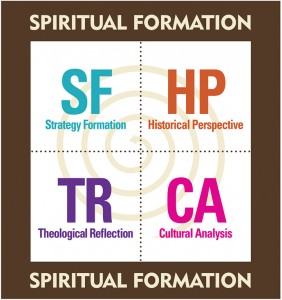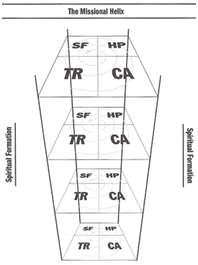I was sitting in a small group of pastors, church planters, and ministry leaders at a 3dm Learning Community, discerning what God was telling us about steps forward in ministry. David described to our group how 25 years ago he had planted the church where he still ministers and which today has over 2,500 members. Though others see him as exceptionally successful, his heart is inwardly perturbed. His church, he says, is more a vendor of goods and services than a community of disciples on mission with God. Attenders (and even members) come with differing motives. For some, it is a duty; for others, it is a place to meet people of influence; for still others, it provides moral instruction for their children. Church attendance assuages guilt and declares to others (and to self) that “I am religious.” A spiritual responsibility has been discharged; therefore, all is well. Observing the worldliness of his members and fearing for the future of his church in an increasing secular culture, he exclaimed, “What have I created!” He was hearing God say that his ministry task during his final era of ministry was to transform this church into a disciple-making community on mission with God.
To leaders like David, the Missional Helix provides a process—a meta-narrative, a way of thinking—to guide them in forming the practices of ministry for church renewal and church planting. 
The Missional Helix[1] visualizes ministry formation as a spiral. The coils turn round and round, passing the same landmarks, but always at a slightly higher level. This spiral, a helix, describes the process of effective ministry formation.
The spiral begins with theological reflection – examining theologies which focus and form our perspectives of culture and the practice of ministry, such as the missio Dei, the kingdom of God, incarnation, and atonement. Cultural analysis, the second element of the Missional Helix, enables missionaries and ministers to define types of peoples within a cultural context, to understand the social construction of their reality, to perceive how they are socially related to one another, and to explain how the Christian message intersects with every aspect of culture (birth rites, coming-of-age rituals, weddings, funerals, and so on). The spiral then considers what has occurred historically in the missional context. Historical perspective narrates how things became what they are, based on the interrelated stories of the particular nation, tribe, lineage, the church, and God’s mission. Finally, strategy formation helps shape the practical methodology of ministry. The Missional Helix illustrates how contextual strategies draw deeply from cultural and historical understandings to theologically discern what God is saying about the practice of ministry and to then develop actual practices to implement the strategies. This shaping of ministry, however, takes place within the environment of spiritual formation as Christian servants humbly submit their lives to a covenant relationship with God as Father and enthrone Christ as their King.
The Relationship between the Five Elements of Ministry Formation
The Missional Helix’s spiral illustrates how the missionary returns time and time again to reflect theologically, culturally, historically, and strategically under the guiding hand of God to develop  ministry models appropriate to the local context. Theology, social understandings, historical development of these understandings, and strategy all work together and interpenetrate each other within this environment of spiritual formation. Thus praxis impacts theology, which in turn shapes the practice of ministry.
ministry models appropriate to the local context. Theology, social understandings, historical development of these understandings, and strategy all work together and interpenetrate each other within this environment of spiritual formation. Thus praxis impacts theology, which in turn shapes the practice of ministry.
The broken lines between the four internal elements of ministry formation demonstrate how each interacts with the others. As Christian leaders humbly and prayerfully submit to God as Father and to each other within an environment of spiritual formation, they find identity, purpose, and are called to mission.
The diagram is called a helix because theology, history, culture, and the practice of ministry build on one another as the community of faith collectively develops understandings and a vision of God’s will within its cultural context. The spiral grows to new heights as ministry understandings and experiences develop. Ideally, the missionary is always learning, growing in the Lord, always spiraling to a new level of understanding and competence.
Ideally, the missionary is always learning, growing in the Lord, always spiraling to a new level of understanding and competence. |
Application
The Missional Helix is useful in at least two ways. First and foremost, it provides a model of decision-making for the Christian practitioner. The practice of mission must become intentional and with experience intuitive. Second, the missional helix provides a model for curricular development in Bible schools, universities, and seminaries. Equipping for ministry should not put high emphasis on some elements and give little consideration to others.
Two questions:
- What elements of the Missional Helix have you generally neglected in developing your model of ministry? What elements have you emphasized?
- How intentional is your current paradigm of ministry? What are the components?
You can read a full development of the Missional Helix of Chapter 13 of 2nd edition of Missions: Biblical Foundations and Contemporary Strategies (Zondervan/Harper Collins).
Dr. Gailyn Van Rheenen, Facilitator of Church Planting and Renewal
Copyright ©2015 by Gailyn Van Rheenen
All rights reserved. We allow you to forward this article individually to friends and photocopy it for personal or class use. Please do not reproduce this material in printed or digital form without reference. If you wish to reproduce this material in printed or digital form or in any other way reproduce or distribute this information, please obtain permission by contacting me at gailyn@missionalive.org.
[1] The Missional Helix was first described in a Missiological Reflection in August 2002 and then applied to church planting in another Missiological Reflection in January 2003. This Missional Helix was used to present the reformist view in the book Evaluating the Church Growth Movement (McIntosh 2004, 167–89).
 Blog
Blog
